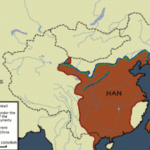As emperor, Liu Bang took the title Gao Zu and set about restoring order and justice to his empire. Although he continued earlier efforts to unify chin, he lowered taxes and eased the Qin emperor’s harsh Legalist policies. In a key move, he appointed Confucian scholars as advisers. His policies created strong foundations of the Han dynasty which lasted from 206B.C.E. to A.D.220.
The most famous Han emperor, Wudi, took China to new heights. During his long reign from 141B.C.E. to 87BCE, he strengthened the government and economy. Like Gao Zu, he chose officials from Confucian “men of wisdom and virtue.” To train scholars, he set up an imperial university at Xian.
Wudi furthered economic growth by improving canals and roads. He had granaries set up across the empire so the government could buy grin when it was abundant and sell it at stable prices when it was scarce. He reorganized finances and imposed a government monopoly on iron and salt. A monopoly is the complete control of a product or business by one person or group. The sale f iron and salt gave the government a source of income other than taxes on peasants.
Wudi followed a police of expansionism by increasing the amount of territory under Chinese rule. He fought many battles. To expand China’s borders and drive nomadic people beyond the great wall of China. Chinese armies added outposts in Manchuria, Korea, northern Vietnam, Tibet, and central Asia. Soldiers, traders, and settlers, slowly spread Chinese influence through out these areas.
The emperor Wudi opened up a trade route, later called the Silk Road, which would link Chine and the west for centuries. During the Han periods, new foods such as grapes, fig, cucumbers, and walnuts flowed into China from western Asia. Lucky trader my return to China bearing furs from Central Asia, muslin from India, or glass from Rome. At the same time the Chinese sent tons of silk westward to fill a growing demand on the prized fabric.
Eventually, the Silk Road stretched for 4,000 miles, linking Chine to the Fertile Crescent in southwestern Asia. Still, few traders cover the whole distance; instead, goods were relayed in stages from one set traders to another. At the western end, trade was controlled by various people including the Persians.
Han emperors made Confucianism the official belief system of the state. They relied on well-educated scholars to run the bureaucratic government. A scholar-official was expected to match the Confucian ideal of a gentleman. He would be courteous and dignified and posses a through knowledge of history, music, poetry, and Confucian teachings.
Han emperors adopted the idea that government officials should in positions my merit rather than through family background. To find the most qualified officials, they set up a system of exams. In time, these civil service exams were given at the local, provincial and national levels. To pass, candidates studies the Confucian classics, a collection of histories, poems, and handbooks on customs that Confucius was said to have complied.
In theory, any man could take the exams. In practice only those who could afford years of study such as the sons of wealthy landowners or officials, could hope to succeed. Occasionally, a village or wealthy family might pay the education for the education of a brilliant peasant boy. If he passed the exams and obtained a government job, hem his family, and his clan all enjoyed immense prestige and moved up in society.
Confucian teachings about filial piety and the superiority of men, kept women form taking the civil service exams. As a result women were closed out of government jobs.
The civil service system had an enormous impact on China for almost 2,000 years. It pt men trained in Confucian thought at every level of government and created an enduring system of values. Dynasties rose and fell, but Confucian influences survived.
As the Han dynasty aged, signs of decay appeared, court intrigues undermined emperor who could no linger control powerful warlords, or local military leaders. Weak emperors let canals and roads fall into disrepair. Burdened by heavy taxes and crushing debt, many peasants revolted. Thousands of rebellious peasants abandoned their villages and fled to the mountains. There they joined secret groups of bandits known by colorful names such as “Red Eyebrows” and the “Green Woodsmen.
In AD220 ambitious warlords overthrew the last Han emperor after 400 years of unity, China broke up into several kingdoms. Adding to the disorder, invaders poured over the great wall and set up their own states. In time, many of these newcomers were absorbed into Chinese civilization.
ACHEVEMENTS OF THE HAN GODLEN AGE
The Han period was one of the Golden ages of Chinese civilization. Han China med such tremendous advances in so many fields that the Chinese later called themselves “the people of Han”
Han scientists wrote texts on chemistry, zoology, botany, and other subjects. Han astronomers carefully measured movements of the stars and planets, which enabled them to improve earlier calendars and invent better timekeeping deices. One scientist invented a simple seismograph to detect and measure earthquakes.
The scientists Wang Chong disagreed with the widely held belief that comets and eclipse showed the Heaven’s anger. “On the average, there is once moon eclipse about every 180 days,” he wrote, “and a solar eclipse about every 41 or 42 months. Eclipses…are not caused by political action.” Wang Chong argued that no scientific theories should be accepted unless they were supported by proof.
Chinese physicians diagnosed diseases, experimented with herbal remedies and other drugs, and developed anesthetics. Some doctors explored the uses of acupuncture. In this medical treatment, the doctor inserts needles under the skin at specific points to relieve pain or treat various illnesses.
In its time, Han China was the most technologically advanced civilization in the world. Cai Lun, an official of the hHan court, invented a method for making durable paper out of wood pulp. His basic method is still used to manufacture paper today. The Chinese also pioneered advanced methods of shipbuilding and invented the rudder to steer. Other practical inventions included bronze and iron stirrups, fishing reels, wheelbarrows, suspension bridges, and chain pumps.


